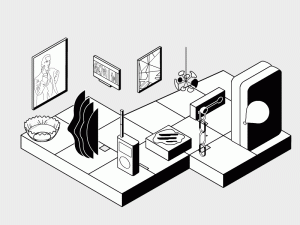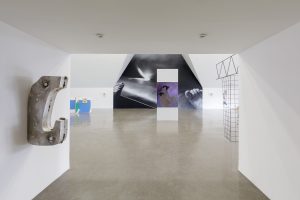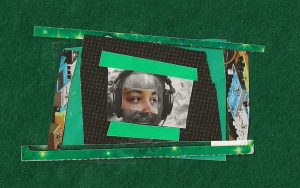Iceberg Projects is a non-commercial art gallery in a converted coach house at the northernmost tip of Chicago. Over the past ten years, Iceberg Projects has hosted a number of historically important shows, especially of queer and other underrepresented artists, including group shows like the Art+Positive archive, Feel Me?, and Broken Flag to solo shows of David Wojnarowicz, Rotimi Fani-Kayode, Kevin Killian, Barbara DeGenevieve, and Steffani Jemison.
Inseparable from the history of Iceberg is the man behind it, whose backyard anchors Iceberg Projects. Dr. Dan Berger is an HIV specialist who helped develop the drug cocktail widely used for treatment. Recently, he released a video offering expert medical insight into how COVID 19 as it particularly affects HIV and queer communities. But his commitment to queer community extends beyond his medical practice and into his art collection, which focuses on queer and black artists.
I visited Dr. Berger in his Rogers Park home to talk about the history of the space. We also talked at length about institutional risk-taking and archiving queer legacies.
+
Noah Fields: So tell me, why did you start Iceberg Projects in the first place?
Dr. Dan Berger: There is a lot of space on this property. This is a house that was built in 1928, with carriage houses built around the property, originally constructed to house horses. At first I rented out most of those spaces for cars when I moved into the house in 1993. But then I was reading this article in The New York Times, Welcome to the Museum of My Stuff, and it talked about these art collectors that wanted to show the work that they’d collected. One of them rented a ground floor storefront to show off the work in their collection, other collectors built spaces or bought spaces to house their collections. Maybe that’s interesting, but I don’t find it as interesting as if I were to use the space to invite other artists to show work. And not being thrilled by some of the exhibitions at our museums at that time, I wanted to fill a void, to show work that the Chicago community would not have otherwise had the opportunity to be engaged with.
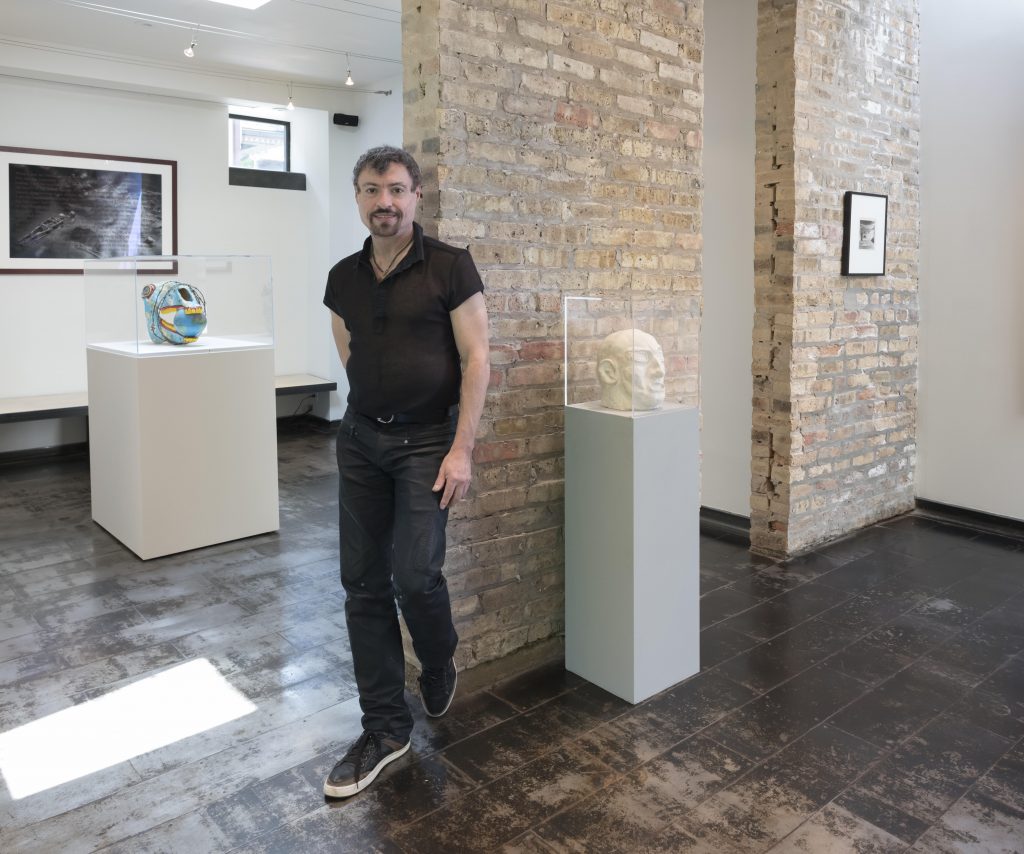
NF: You became less interested in showing your collection, so much as opening up your space for other people’s work.
DB: Yeah, I don’t use the space to show work that I have in my collection. Our committee, which I am a member of, works together to choose our exhibitions. For example, the show right now, Rotimi Fani Kayode, was a gay artist of African descent who died prematurely due to AIDS. I don’t own any of this work. Have I had work in a show here during the course of almost ten years of showing work here? Maybe twice, maybe three times. But we generally show work by artists who have not been shown at any of Chicago’s museums or institutions.
I enlisted the help of my friend Robby [Robert MacNeill], who was a young architect living in Philly, to help renovate and construct a state-of-the-art gallery space, inspired by the designs of Carlo Scarpa. And I later called Doug Ischar and John Neff to help begin to construct a board and program. Our first exhibition was a sculpture show called “Robert MacNeill: Frozen Music.” That was in May of 2010.
Most of my friends and most of my community are artists. That’s who I prefer to hang out with. My family includes many art and artist friends, assorted queers, my brother and his family, my partner Scott and our dog. I think about something you and I have talked about, “queer lineage.” We’ve needed to construct our own families, our own lineage. Iceberg is an extension of my beliefs and queer confidence; all these ideas became part of the forumula of components that resulted in Iceberg Projects becomming a Chicago institution.

NF: Given Iceberg Projects’ queer focus, I think it would be helpful to hear what you think the word “queer” means and what you think queer art embodies?
DB: What does “queer” mean to me? It’s a loaded question. Well, I mean, I can talk about the academic definitions and heteronormativity … but maybe I can just talk a little bit more personally. When I came into the practice of medicine, access to healthcare was insufficient for people that were queer and other communities struck by a life-threatening disease [AIDS]. It felt very personal to me that the medical community and the government were not interested in helping nor educating our community nor conducting proper research though it was in great need.
I think “queer” is anybody that finds themself being censored because of their identity, because they don’t fit into the mold because certain governing officials want to manipulate and force their bible thumper dictates upon everyone. Anyone that’s being censored. Anyone that’s the victim of homophobia, AIDS-phobia, racism, misogyny, all of that. I suppose it’s a very wide definition.
NF: Well, I can see how this broader definition resonates with the breadth of Iceberg’s programming. The shows Iceberg puts on challenge the masculinist or whitewashed biases of “queer art” that I’ve seen a lot of other places reify, as if AIDS only affected white men. It seems to me like Iceberg Projects goes beyond that narrative, explodes it in a lot of ways.
DB: Yeah, absolutely. The patients I was seeing in the clinic were from many different cultural histories. I would see African Americans that are victimized by racism, but then factor in the fact that they happen to be queer. And factor, on top of that, that they’re HIV positive. It’s even more than a white gay man might have to deal with at times, but not to say that any gay man in general didn’t have to deal with a lot of prejudice and censorship in their own right. All of those communities deal with prejudice and stigmatization and at their various levels. It definitely affected me and definitely affects the way I see the world and to the point where I want Iceberg Projects to contribute to this discourse and of seeing a world where we all get as much of a chance to survive as anyone else.
Artists that portray that message, that are angry, resonate deeply with me. It’s guttural. It’s unfortunate that museums had the ability to be thinking outside the box and have the ability to be able to portray work that can send a powerful and particular message to help change society and change the world, but they are often governed by a board of directors, and some of those people are from wealthy families that have other interests. I think museums are getting better now, but queer is still left behind. It’s unfortunate, but we have to pedal uphill. Constantly fight for our right to exist and for our right to be represented.
Iceberg’s a very small space, but I and our board want to make sure that every show that we do has a high or particular quality, showing artists that are mature, and work that is anything but meaningless. I don’t enjoy seeing work that has no message; that means nothing. I’m not into seeing pretty things on a wall.

NF: And for a “backyard gallery,” Iceberg Projects has done an incredible amount of significant shows over the years. I mean, the David Wojnarowicz show when the Whitney show almost didn’t happen … and so many other major artists and group shows.
DB: The David Wojnarowicz show [“David Wojnarowicz: Flesh of My Flesh”] is a perfect example. Here’s an artist that was being censored in 2017, long after he’s dead. We were concerned that an important show that was supposedly planned, was not going to ever happen. And why isn’t it traveling to other institutions? Censorship is still here.
We mounted a show of work by an esteemed teacher at the Art Institute [of Chicago], the late Barbara Genevieve, curated by Doug [Ischar] and myself. Barbara passed a few years ago and she taught a Sex 101 class, very important and ahead of its time, but at that time, certain members of the board at the School tried to shut her down. They suspended the class. Fortunately she was tenured, so she wasn’t gonna lose her job. But she was a victim of censorship and she was being challenged as an artist in her own right. She rarely had exhibitions of her own work before she passed, despite the fact that she was a true artist. She was a terrible loss for the queer and art communities. She was a great teacher who had this amazing quality that affected and inspired many future generations of artists. Even today, I meet new artists around the country who recount stories about her and what she meant to them and their work; I felt that the school ought to honor her; she deserved this.
Because I’m on the board of governors of the School of the Art Institute, I could call on my colleagues and ask them for help. And they were very supportive, of course. But again, she was faculty at one of the most prestigious schools in the country; nevertheless, she had to deal with a lot of those similar [censorship] issues while she was alive. Some of the more controversial aspects of her practice were her films which were at times graphic. We showed these films here at Iceberg; they are rarely seen now, but I’m very proud that we did so.
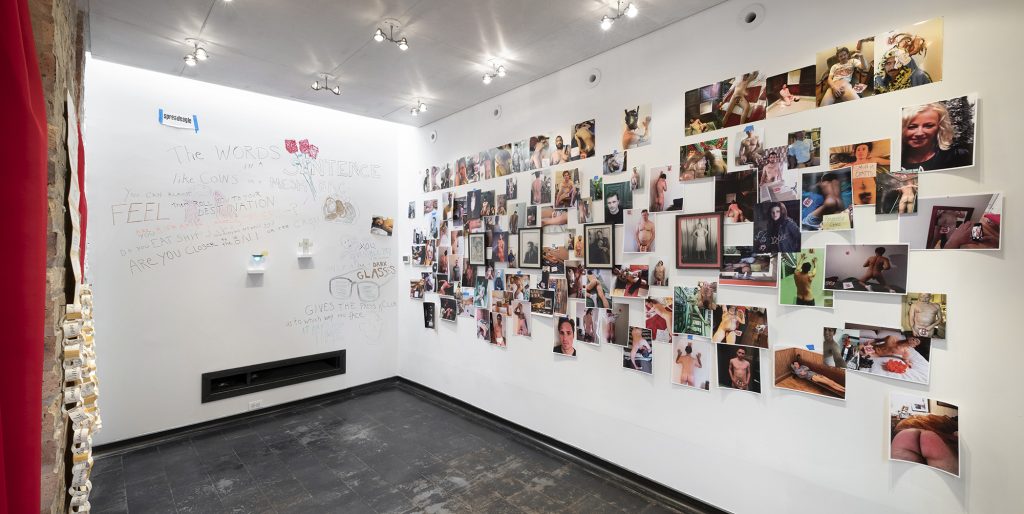
NF: Iceberg is a space that’s not afraid to take risks. And I imagine part of that is because it’s a noncommercial space?
DB: It’s not a commercial space. We have no status whatsoever, we’re not governed by any institution. I use the word “we” and I mean that literally. I’m not the person that does all these shows—we have a very great board which functions as an exhibitions and curatorial committee and we talk about what we think will be interesting, what the Chicago public wouldn’t otherwise get a chance to see. No one gets paid. We all do this because we’re dedicated, very passionate about our vision and our mission. We’re not bound by anyone. That is how we can take chances and do things that you won’t see at other institutions.
The Wojnarowicz show is an example of how we function. It was all very spontaneous. I was out with some friends who also collect David’s work, with Wendy Olsoff, who is the co-owner of P.P.O.W. gallery and who represents and helps manage the Wojnarowicz estate. We’re having dinner, and we were just talking about how frustrated we were that the original date for the [the Whitney Museum’s] Wojnarowicz show was no longer listed on the website, and there was nothing further listed, nor any explanation. We wondered whether there was even gonna be a show—I was very upset about it. We were so looking forward to it. And I said to Wendy, “Why can’t we just do a show here in Chicago?” And she said simply and without any hesitation, “I’ll help.”
I took it to the board. We had a quick discussion about it. Nobody raised any objections. Actually the board recommended we move on this quickly. The Wojnarowicz show at Iceberg Projects ended up opening several weeks prior to the Whitney’s.
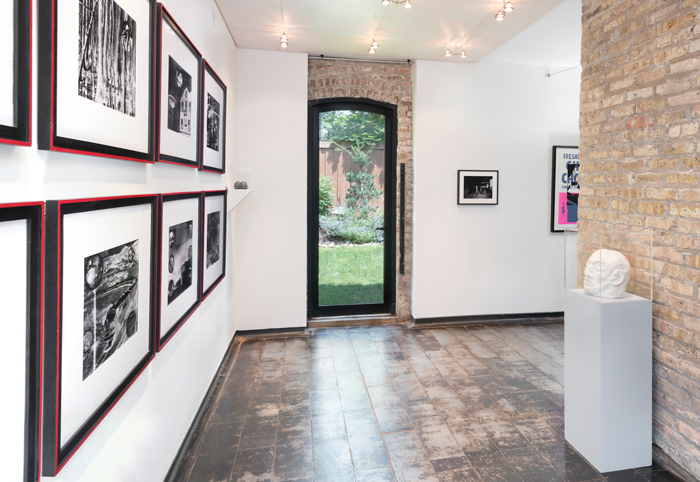
NF: David Wojnarowicz’s first show was in Illinois, right? His first solo show was in Normal?
DB: In Normal, Illinois, in 1990, yeah. But he never had a solo show in Chicago during his lifetime. So this exhibition at Iceberg Projects was actually the very first solo show of the artist in Chicago. Barry Blinderman, the curator of Wojnarowicz’s first institutional show, came up for the opening and I seized the opportunity to ask him if he’d do a discussion with me about Wojnarowicz during our upcoming film program on Northwestern University’s campus at the Block Museum. And it’s all beautifully reproduced in a book that is distributed by SPD [Small Press Distribution] of Berkeley California.
When the archives of ART+Positive first arrived here one early morning, I called our board members together the same day and I explained that they had to come over to experience it, and that we must do this show. John [Neff] was among the first who looked at the archives with me and soon everyone on the board was in awe of the archives and their significance. The work in the archive was buried for many, many years. In a matter of a few months John and I mounted a show. How can that happen at another institution? It would take years. They’d be looking at it, writing about it, poring over it, going through various committees, discussing it, masturbating over it…
NF: That makes me think about your work as a physician, like the way you went ahead with experimental treatments that the government was holding up. But you knew we didn’t have time to wait. People are dying and we need to act.
DB: Yeah. So I put these concepts and strange and crazy habits of mine into practice at Iceberg Projects.
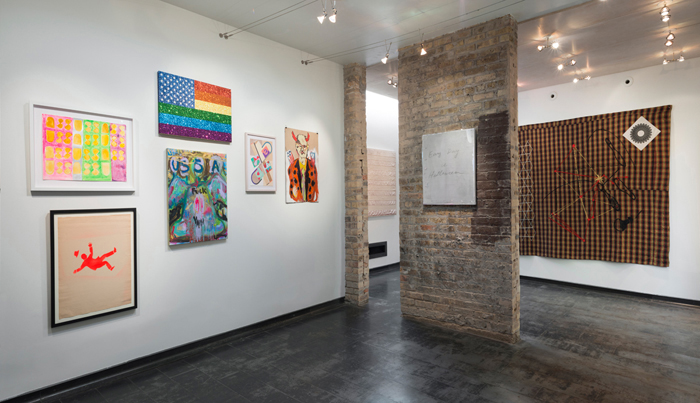
NF: I’m thinking about this connection between your practice as a physician and your art collection, working as a curator. I love how the etymology of “curation” comes from “cura,” like a cure: it’s caretaking. There’s a parallel. I’d love to hear more — I know we talked about how the people in the art world and the medical world are very different, but I also wonder about the parallels, because you’ve made it work and I’m just very curious how you’ve had your hand in both. Do your practices feed each other?
DB: I came of age as a young medical doctor in a situation that was grave, where you had to think outside the box, you had to learn how to do things in a way that would help save lives. You had to work within the system at times, but sometimes you had to work outside the system and knowing that the possibilities are there: you can work outside of the system, you can do things, you just have to figure it out.
And having learned how to do that in medical practice, then seeing the censorship and homophobia in the art world — maybe not as grotesque and maybe not as severe and as intense, but nevertheless, seeing that it’s still possible to break through that, working maybe within the system, but also outside the system. That those possibilities are there for anybody that wants to make the effort and wants to figure it out.
I approach every problem as a puzzle. You know, they’re pieces of the puzzle that just need to be put together. And you just have to sit down and look at all the pieces and figure out how they fit.
NF: I also want to hear more about the publication side of Iceberg Projects. You’ve produced catalogues and documentation of some of the shows. What are you hoping to capture with these catalogues? Are you envisioning these being more for people who saw the exhibit or for people who didn’t get to see the exhibits? How do you think printed press can ensure the surviving legacy of queer artists?
DB: I have been wrestling with it quite a bit. Obviously publications are difficult to do and they require commitment and time. Everyone’s busy with their lives and we’re not a big institution. So there’s a little bit of an obstacle in terms of doing as many publications as we’d like. So we choose what is feasible and important. Shows featuring deserving artists who didn’t get their due and have an important message that needs to be seen and heard. If you don’t have a catalogue, once the show closes, memory is short-lived. And I think we need to be able to leave some document later for historic reference. It’s important for people to be able to revisit or study the art and perform proper research.
So one way that we try to accomplish that is we try to have all the shows on our website. If you click on any show, you’ll be able to see installation photos and their details, no matter how far back you go. That’s been very important to me. But also it’s important to have catalogues where people can write some essays and invoke conversation about the work. Both have the potential of reaching a much wider audience, so people that don’t get a chance to see a show in Chicago are able to see the catalogue or view the complete exhibition online. The ART+ Positive book [“Militant Eroticism: The ART+Positive Archives”] is carried in most of the major museums around the world.

NF: That brings to mind Iceberg’s mission of global dialogue: “Iceberg brings artists producing work with depth and substance to the attention of local and regional communities. The gallery is also invested in bringing Chicago-based artists into dialogue with global developments in contemporary art.” I’m curious how you think about the relationship between the local and global?
DB: I think we live in a global society, and we have to approach many world issues day-to-day. The current government and administration in Washington affects us, not just here in the United States, but everybody globally. So our show “Broken Flag,” which you just quoted the statement in the back of that catalogue, was a response to what we feared most about that election. That show was planned prior to knowing the results of the election.
We opened that show the weekend before the election. We couldn’t imagine that Trump was going to win. We couldn’t see how that was possible. But we were scared of the mere possibility. And that was the subject of the show and essays in the catalogue and exhibition that Omar Kholeif and I curated. We saw what happened before the election; let’s talk about how those fears became reality and their ramifications globally. They weren’t just hypothetical. And that’s something that, you know, I’m still thinking about and wondering about what we need to do. What we can do.
I do think about activism, and I don’t know what defines activism these days. Unfortunately, we have very little of the type of the depth and intensity of activists that were around during the AIDS epidemic. We don’t really have the level of activism that we had before, you know. Which I find very sad and frustrating.
But as artists, I think it’s a responsibility of artists to promote change. I think that artists can send those important messages and influence the public. I see Iceberg as playing a small role. Sometimes it takes a village, so to speak. You know, not one single person in one single institution can do things on their own.
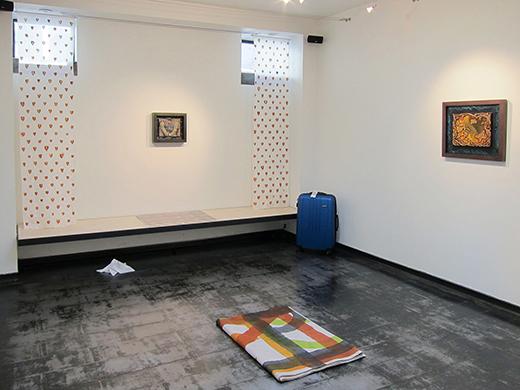
NF: I’m wondering about the name for Iceberg Projects, how did you come up with that? It feels like it’s political or globally minded.
DB: [laughs] Well, my last name is Berger … But that wasn’t the main reason. We’re at the tip of the iceberg here on the north side of Chicago. From the very last block of Chicago, you walk a few feet up north and that’s Evanston. Then I was thinking about how cold it gets to be in Chicago through the winter. [laughs]
It wasn’t chiefly political, but there is a political reference to it. With global warming, of course, and it also makes me think about a painting by David Wojnarowicz [“North/South: The New Legionnaires”] where he portrays the Titanic about to collide into an iceberg. How the world in our present situation feels like it’s on a path towards destruction. It’s a name that evokes and resonates on multiple levels.

NF: Iceberg is in its 10th season. Are there any plans for a celebration or retrospective?
DB: We’re going to talk about that. I don’t know. I’m pretty surprised that we’ve gone this far, that it’s already 10 years. We did have an intern last year, and he created a sort of compilation of all the shows that we’ve done up till like last year. Maybe we can create some kind of publication … nothing’s been formulated yet.
NF: What are the visions for the next decade?
DB: To survive. I think to continue with telling a narrative in a way that we feel is important. I think our shows have themes that sort of fit in with themes of other shows. We think about how things sort of fit together, but we also want to be inclusive and make sure that we’re showing work by artists that have different messages, the work should be varied. So we would like to exhibit varied and meaningful work, although I think of the space as being “queer,” not every show is. Shows don’t have to be queer that come to be an Iceberg exhibition. We’ve shown work by African American artists that are not queer, we’ve showed artists that talk about the environment. We have different programming, and we want to continue raising the bar with the quality of our exhibitions. We are open to input and collaborating with other curators. We’ve been doing that more and more and it’s been a bonus. And what else? We’ll find out… we don’t plan that far ahead.
NF: Well, thank you so much for taking the time to walk me through Iceberg’s history and telling me more about where it’s heading.



Noa/h Fields is a genderqueer poet and teaching artist. They have written for Filthy Dreams, Telekom Electronic Beats, Anomalous Press, and Scapi Magazine, among other publications. Their first poetry book WITH is out from Ghost City Press. They are fond of techno and avocados.

